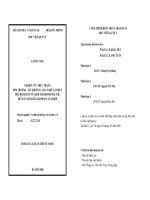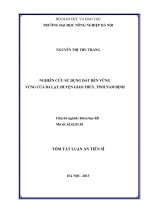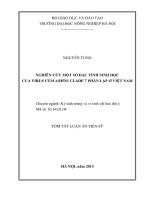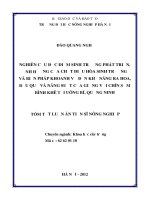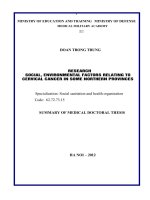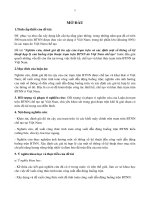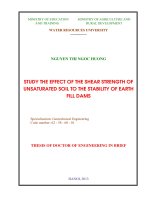tóm tắt luận án tiếng anh nghiên cứu thực trạng môi trường, sức khỏe của người chăn nuôi gia cầm và giải pháp can thiệp tại huyện phú xuyên, hà nội
Bạn đang xem bản rút gọn của tài liệu. Xem và tải ngay bản đầy đủ của tài liệu tại đây (190.45 KB, 24 trang )
BACKGROUND
In Vietnam poultry tradition, especially in the poultry of
small households still thrive. During poultry certainly affect the
environment and human health, poultry are very close to humans, and
is the host carriers may directly or indirectly spread to person. In
recent years, the prevalence of diseases originating from poultry to
people and communities are as real burden H5N1 flu strain
(appearing in 2003) and more recently (2013) the A/H7N9 flu
vaccine has, are emerging and circulating disease burden in China
and Taiwan, although so far the disease has been controlled, but risks
remain in many local recurrence.
To help reduce the risk of occupational hazards, protect
and improve the health of poultry workers, the study of the
environment, working conditions at the barn/farm, conducting
clinics filtering, detection of disease for workers in the household
poultry production is necessary, so we carried the theme:
"Research on situation of environmental, health of poultry
farmers and intervention measures at Phu Xuyen district, Ha
Noi" with the following objectives:
1. Description reality environment, health, knowledge,
preventive practices of poultry farmers.
2. To assess the effectiveness of interventions to improve
knowledge, practice rooms spread from poultry disease
of poultry farmers.
1
THE NEW CONTRIBUTION OF THIS THESIS
Meaning of scientific topics:
Topics additional scientific data on pollution levels in the
small poultry farmers.
Give us the knowledge and practice of disease prevention
poultry farmers
Initially identified a number of common diseases of poultry
farmers
Seeing the meaning of community intervention research
controlled.
Practical significance
Thread has shown the effectiveness of education and
communication on environmental protection, disease prevention,
health promotion for the poultry farmers.
Subject was also pointed out that in addition to the task of
health workers, local vets, the social responsibility also extremely
important in the prevention of diseases related to poultry production
environment.
The new threads
Provides database of poultry pollution, disease patterns of
poultry in the household.
Highlighting the significance of effective community
intervention control (efficacy between the intervention and control
groups) rather than merely evaluate the effectiveness of pre-and post-
intervention. Because the effectiveness of the education community
are influenced by many sectors and many different media.
STRUCTURE OF THE THESIS
The thesis consists 115 pages, in which: background 2 pages;
Chapter 1: Overview, 29 pages; Chapter 2: Subjects and research
methods, 16 pages; Chapter 3: Research results, 34 pages; Chapter 4:
Discussion, 31 pages; Conclusions, 2 pages; Recommendations, 1
page. References is 101 including 58 documents in Vietnamese and
43 documents in English. The thesis is presented and illustrated with
35 tables, 8 charts, 3 pictures, 1 diagram and 6 appendices.
2
Chapter 1
OVERVIEW
1.1. Situation of poultry environment and health of poultry
farmers
1.1.1. Situation of conditions and poultry environment
Up to 80% of household poultry production, but only 15% of
the poultry industry basis, 20% of poultry farming in semi-industrial
methods, while up to 65% of poultry by traditional methods (less
than 200 poultry). The waste from the barn/farm in which solid waste
from poultry feathers, feces, garbage litter, waste products from the
food, even the bodies of dead poultry is very large (about 16,5
tons/year) and almost discharged spontaneously never treated [9].
Especially since 2003 in Vietnam when we have avian flu A/H5N1
flu appears, circulation and spread to humans so far, the local
epidemic and have destroyed most: former Ha Tay (present Hanoi);
Ho Chi Minh City, Dong Nai, Long An and An Giang.
1.1.2. The reality of the health of poultry farmers
In general, the poultry farmers is not interested in health care
and health protection separately, there are not in-depth study of the
health of the poultry farmers, there are some few studies on large
farms industrial nature, but for the small poultry farmers are also
disadvantaged almost no mention research.
1.1.3. Situation of environmental protection in Agriculture
The amount of new agricultural waste collected in the city,
only to be 45-55%, in the rural areas hardly collected, which caused a
major influence on environmental sanitation, the which is typical of
wastewater from the poultry pens pollute the air, land and water
resources that are of concern surface water and shallow groundwater,
3
this is the main source of drinking water of people living in rural
areas [38].
1.2. Theoretical basis related to the environment and their impact
on the health of poultry farmers
1.2.4. The disease is caused by direct contact with poultry
environment
Diseases of allergic and immunology: eye diseases, diseases
of the nose and throat, respiratory disease, dermatitis, nail desease
(onychomycosis).
Scrub typhus: caused by infection of Trombicula Rickettsia
tsugamushi disease, also known as Rickettsia orientalis transmission
penetrate through blood and burning incision human pathogens.
Diseases caused by microorganisms: bacteria, viruses and
fungi, and parasites.
1.2.6. Occupational diseases and diseases related to occupational
The poultry frequent daily contact with the environment, such
as air, soil, sewage, including many pathogens, such as chemicals
used in farming (for food, hygiene, disinfection housing, preventive
and curative drugs for poultry ), the waste product directly or
indirectly from birds such as fertilizer dust, feathers, and the
decomposition products after , the spread from poultry or by
contact such as bug burn, dermatitis, mucositis (inflammation of the
nose and throat, inflammation of the cornea), or allergic stimuli, the
mental condition of being affected by the size love or unpleasant
odor. And so the animal can work with a number of disease-specific,
nature-related careers.
4
Chapter 2
SUBJECTS AND RESEARCH METHODS
2.1. Subjects of study
2.1.2. Selection criteria for the study subjects
2.1.2.1. For the poultry farmers
- Age: from 18 to 65 years old.
- Time directly involved in poultry farmers is at least 1 year.
- In a week for poultry feed and cleaned the poultry barn at
least 4 times/week
- Agree to participate in collaborative research.
2.1.2.2. For the conditions and environment in the barn/farm of
poultry households
- Barn/farm in poultry households (including: chickens, ducks,
and geese) at least 3 years.
- Households with number of poultry in barn/farm from 100 to
200 piglets/litter (small poultry farms)
2.1.2.3. Subjects checkup health: all members of the family which
poultry household choice.
2.2. Research locations
- The study was conducted intentionally in two Hong Thai
commune and Dai Xuyen commune, Phu Xuyen district, Ha Noi.
Two communes geographical conditions, population alike. Choose an
intervention commune with poor sanitary conditions and a non-
intervention commune was the control:
- Hong Thai commune was selected as interventions commune.
- Dai Xuyen commune was selected as control commune.
2.3. Research Methodology
5
2.3.1. Study Design
Study design used in accordance with 2 stages of the research
topic:
2.3.2. The first stage: Research of cross-sectional descriptive
2.3.2.1. Sample sizes
The sample size unit is "household". Sample sizes were
calculated using the formula "estimated percentage of the
population":
( )
( )
2
2
2/1
1
d
pp
Zn
−
=
−
α
Among them:
p: the proportion of households not raising hygiene
standards with p = 97% (0,97)
Z
1-α/2
= 1,96 corresponding to a statistically significant
level α = 0,05 and 95% confidence
d: absolute precision p. Choose d = 5%
- The result for n approximately equal to 45, to ensure the
effectiveness of our design is to calculate the sample size, design
effect (DE) by 2. Thus, the households of both communes selected to
participate in the study be 90 households, and 45 households in each
commune randomly selected unit.
- For health content: Physicals for all persons in 90 households.
- Survey of microclimate factors: survey sample of 46 households in
90 household.
6
+ Use sampling techniques, sample analysis as "routine occupational
health engineering, environmental sanitation, school health" of the
Institute of Occupational Health and Sanitation ", in 2002.
2.3.2.2. Research sampling techniques: Using techniques of
sampling was multi-stage.
- Stage 1 - Choose district study: sample intentionally, its Phu Xuyen
district, Ha Noi.
- Stage 2 - Choose communes studies: Choose intentionally took 2
communes, Dai Xuyen and Hong Thai.
- Stage 3 - Choose households according to research random
sampling unit
- Stage 4 - selected participants from the study households.
Quantification of CO
2
in the air: Using electronic meter model
number M170 VAISALA Finnish Company.
Quantification of H
2
S and NH
3
: Using adsorption method through
solution adsorption SKC air blower of America, then analyzed in the
laboratory using a UV-VIS laboratory British
Quantification of H
2
S and NH
3
in the air: Using sampling, 5 liters
of air suction. Quantitative laboratory scale using a colorimetric
method templates.
The concentration of ammonia in the atmosphere by the
formula:
0
.
.
Vc
ba
= mg/l
Among them:
a: scale tubes of ammonia in the sample (mg)
b: total volume of solution adsorption (ml)
7
c: the volume of fluid removed absorption analysis (ml)
Vo: the volume of air sampled (liters)
H
2
S: Sampling analysis: In adsorption tube containing 6ml Gellman
adsorption solution, sucking air through 500ml/minute pace. Get 15
to 20 liters of air.
Hydro sunfua concentration (X) in the air in mg/l as follows:
X =
0
.
.
Vc
ba
= mg/l
Among them:
a: H
2
S concentrations corresponding to scale the chart pattern
or sample (mg)
b: to bring the solution to absorb used (ml)
c: removed liquid adsorption analysis (ml)
Vo: the volume of air sampled (liters)
+ Engineering microbial sampling: Using the method of direct
deposition of Koch.
Calculate the total number of aerobic microorganisms (X) in 1
m
3
of air by the formula:
KxS
xxA
X
100100
=
Among them:
A: The average colony barn/farm of 5 boxes;
S: Area agar plates, cm
2;
K: coefficient of time (1, 2 or 3);
100: convention area, cm
2;
100: the transfer coefficient of m
3;
8
According Romanovic in food production base, very good
atmosphere as only under 20 colonies on the agar surface for
10 minutes and no pineapple mold, good to have 20-50
colonies of bacteria and 2 clusters mold, just as there 50-70
pineapples and pineapple mold 5; worse when over 70 colonies
of bacteria and over 5 pineapple mold.
+ Physical examination: Physical examination for all 426 members
of 90 households in commune health stations by the hospital's
Agriculture doctors. Later analysis of disease and health situation in
two subjects: 185 subjects were eligible to participate in research and
the remaining 104 subjects of the same age.
2.3.2.3. Tools to collect information on knowledge, attitudes and
practices of animal husbandry objects directly:
- The interview questions of knowledge, attitude and practice of live
animal subjects.
- Checklist sensory evaluation sanitation situation of the poultry
household.
- Disease research: Samples shall be taken from medical records of
Agriculture hospital
2.3.3. The stage second: the intervention study communication
behavior change of poultry:
2.3.3.2. Content intervention
Materials used: documentation "health safety in poultry"
Scientific Research Institute of Technical Protection of the General
Confederation of Labor, workers in Vietnam.
9
2.3.3.3. Interventions
- Communicate education and health
+ Organize to training knowledge, discussions, communicate
directly;
+ Distribute brochure and materials for 45 households; radio.
+ Activities:
1) Prepare documents and printed flyers.
2) To organize training courses: two courses for the members directly
involved in farming (interview, survey) of 45 households
+ Training time: 2 days/1class.
+ Location: in the commune
3) Distribute brochure to every household
2.3.4. Data processing intervention effectiveness evaluation:
The data collected after entering EpiData 3.1 software, then
switch to the software SPSS 18.0 for target indicators in research
+ Index of the intervention effect (T-S) in the control group
(H
1)
= {(rate of post-survey - rate of pre-survey) / rate of post-survey}
x 100%
+ Index of the intervention effect (T-S) in the intervention
group (H
2
) = {(rate of post-intervention survey - rate of pre-survey) /
rate of post-survey} x 100%
Effective interventions (H
3
)% = {(rate of post-intervention
survey in the intervention group - rate of pre-survey in the control
group) / rate of post-survey in the intervention group} x 100%
10
Chapter 3
RESULTS
3.2. Situation of environment, health, knowledge, preventive
practices of poultry farmers
3.2.1. Situation of environmental of poultry
Table 3.3: Results of measurement of microclimate and toxic gas in
barn/farm
Microclimate limit
Dai
Xuyen
(n=23)
Hong Thai
(n=23)
p
General
(n=46)
X
SD
X
SD
X
SD
Temperature
(ºC)
20
o
C
–
35
o
C
37,5 1,86 35,3 2,3 p<0,05 36,4 2,36
Humidity
(%)
<
80%
54,6 7,15 64,5 11,57 p<0,05 59,5 10,76
Tốc độ gió
(m/s)
0,2
m/s
0,3 0,16 0,2 0,05 p<0,05 0,3 0,13
CO
2
(mg/m
3
)
900 870,5365,32 825,59 80,86 p<0,05
848,0
6
46,15
H
2
S
(mg/m
3
)
17 1,21 0,28 1,11 0,29 p>0,05 0,93 0,22
NH
3
(mg/m
3
)
10 2,35 0,47 2,13 0,63 p>0,05 1,85 0,32
According to the hygiene standards of 3733/2002/QD-BYT,
Average outdoor temperature during the day is frequently measured
at Dai Xuyen is 37,5ºC and Hong Thai is: 35,3ºC
11
Table 3.5: Elements of microorganisms in ambient of the air at
barn/farm (/m
3
in the air)
Microbial
factors
Dai Xuyen
(n=23)
Hong Thai
(n=23)
p
General
(n=46)
X
SD
X
SD
X
SD
Aerobes/
m
3
27.773,644.280,1143.467,7124.733,8 < 0,05 85.620,7109.478,8
Mold/m
3
4.057,6 4.330,1 14.421,1 15.297,6 < 0,05 9.239,4 12.298,1
Bacteria
that cause
hemolytic
/m
3
1.379,3 1.123,5 2.959 1.551,3 < 0,05 2.169,2 1.559,3
- Dai Xuyen some aerobic bacteria averaged was 27.773,6 ±
44.280,1 bacteria/m
3
, Hong Thai commune was 143.467,7 ±
124.733,8 bacteria/m
3
. Barn/Farms of one poultry household at Hong
Thai commune had aerobic bacteria reached 4,62 million bacteria/m
3
in the air. The difference in the average amount of aerobic bacteria
are statistically significant.
- The average amount of mold in Dai Xuyen was 4.057,6 ±
4.330,1 spores/m
3
, Hong Thai commune was 14.421,1 ± 15.297,6
spores/m
3
. The difference was statistically significant.
- The amount of bacteria that cause hemolytic Dai Xuyen
average was 1.379,3 ± 1.123,5 regular bacteria/m
3
, Hong Thai
commune was 2.959 ± 1.551,3. The difference was statistically
significant.
- There was 43,3% of households with backyard
field/pond/lake.
- Distance from barn of poultry to house mainly in two
communes accounted for 56,7% less than 1m.
12
3.2.4. Situation of the health of main poultry farmers (participate
in research)
Chart 3.5. Research participants with a number of major
diseases
- 4 most common diseases: chronic angina (43,8%); skin
diseases (35,7 %); chronic bronchitis (29,2%), allergic sinusitis
(19,5%), gastritis (22,2%).
- The results showed that the contact group on 4 times/week
with rates of bronchitis sufferers higher than among poultry exposed
to 4 times/week (29,2% compared with 13,5%).
- Bronchial asthma incidence also differed significantly
between the 2 groups (8,6% compared with 2,1%).
- Skin Diseases exposed groups over 4 times/week with a high
prevalence was 35,7% in the group exposed 4 times / week rate is
4,1%.The difference is statistically significant with p <0,05.
- Similar to the above diseases: chronic angina appeared on the
2 groups was 43,8% compared with 17,8%, and 11,9% fungal nail
infection compared with 1,2%. The difference above are statistically
significant with p < 0,05.
13
3.3. Effective intervention, education and communication
3.3.1. Intervention effect change environmental conditions
Table 3.32: Situation of ambient barn/farm
Situation of
surroundings
Dai Xuyen (DX)
(control)
Hong Thai (HT)
(intervention)
compare
post-intervention
Pre
n=45
Post
n=45
H
1
%
Pre
n=45
Post
n=45
H
2
%
DX HT
H
3
%
Clean and tidy 1 3 66,7 0 16 100 3 16 81,3
With sewers
wastewater
14 15 6,7 13 37 64,9 15 37 59,5
With compost
pits
8 7 12,5 4 35 88,6 7 35 80
Dirty 38 37 2,6 4 9 79,5 37 9 75,7
- Effective intervention to clean the surroundings before after
Hong Thai commune was 100% and efficiency compared with
control commune reached 81,3%.
- Effective interventions to the household drains at Hong
Thai commune was 64,9% compared with the control group and this
effect was 59,5%.
- Effective interventions to households’ compost pit at Hong
Thai Commune was 88,6% compared with the control group and
reached 80,0%.
3.3.2. Intervention effectiveness changing knowledge, practice
14
Table 3.35: Knowledge of objects for transmitted diseases
poultry
transmitted
diseases
poultry
Dai Xuyen (DX)
(control)
Hong Thai (HT)
(intervention)
Compare
post-intervention
Pre
n=45
Post
n=45
H
1
%
Pre
n=45
Post
n=45
H
2
%
DX HT
H
3
%
Avian
Influenza
18 26 30,8 21 90 76,7 26 90 71,1
Scrub Typhus 34 33 2,9 31 65 52,3 33 65 49,2
Skin disease 20 41 51,2 21 82 74,4 41 82 50,0
Bronchial
asthma
3 5 40,0 3 29 89,7 5 29 82,8
Pneumonia/
Bronchitis
1 8 87,5 6 46 87,0 8 46 82,6
- Effective interventions for Hong Thai’s people that can
spread the influenza from poultry to human was 76,7% (pre-post
survey). After that, compared with the control group, the intervention
effect was 180,8%.
- For bronchial asthma patients. Effective intervention of pre-
post was reached 89,7% and the control group was 93,2% efficiency.
- After the intervention, Hong Thai the percentage of infected
poultry sold to reduce by 93,3%. Compared with the control group
this effective was reduced by 93,2% of people bring infected poultry
to sell.
15
- Effective interventions for people to report vets when
infected poultry was 58,9%, compared with the control group, this
effective reached 83,5%.
- Effective interventions for poultry farmers use for individual
safety Hong Thai Commune was 44,0%, compared with the control
group reached 25,3%.
- Effective intervention to destroy the entire poultry and
poultry disease reached 97,1%, compared with the control group
intervention was 94,3%.
- Effective interventions to poultry farmers in Hong Thai
commune disinfect regularly perform reached 92,8%, while
compared with the control group, this intervention effect was 90,4%.
- Effective interventions to poultry farmers used to gloves
reached 91,0%, compared with the control group intervention so this
effective reached 79,1%.
- After the intervention, the percentage of people wear goggles
in Hong Thai commune was 41,8% compared with 2,9% in Dai
Xuyen commune. Effective intervention pre-post Hong Thai
commune wad 100%, compared with the control group, the
intervention effective was 94,7%
Chapter 4
DISCUSSION
16
4.1. Situation of some factors environmental, health, knowledge,
preventive practices of poultry farmers
- Poultry households mainly have barn/farm immediately
adjacent, even difficult to distinguish separated from the housing. If
they are near the house of toxic gases such as CO
2,
H
2
S, NH
3
will
cause air pollution and human exposure to high levels of continuous,
prolonged will cause a number of diseases, even toxic nerve,
stimulation of mucosal diseases such as eyes, respiratory mucosal
system generally leads to prolonged chronic respiratory diseases
cause pulmonary fibrosis, bronchial asthma or bronchitis career;
ability to transmit a number of diseases from birds to humans is very
easy as eggs or larvae infected with trichuris, hookworm, tapeworm
and cause diseases of the digestive system such as bacillus dysentery,
typhoid, and Fungal diseases such as skin fungus, the pathogen
causing gastrointestinal or respiratory diseases, especially acute
disease transmitted through respiratory particles suspended in air
carrier (viruses, bacteria ). In addition, owing to the near poor
sanitation such that should the insects (cockroaches, ants, the curious
type, centipedes ) in the burning barn will also ease inflammation,
itching, discomfort, notably Chicken fat is burned the inflammation,
itching, lesions on the spot and through intermediate hosts that can
transmit a number of diseases including fever typically curious
(tsugamushi disease).
- As well as the findings of Truong Thai Ha and colleagues is
the only household cleaner as the dirt (70%), not destruction or
disinfection measures barn/farm after harvest or after disease is
64,3%. Even ambient barn/farm (even golf, summer houses) through
observation, we found that there were 91,1% more dust is distributed.
17
- The result of the study we found that for direct farmer ratio is
4 common diseases: chronic throat inflammation (43,8%), skin
diseases (35,7%), inflammatory lung disease management of chronic
(29,2%), digestive diseases (22,2%), consistent with studies of Tran
Nhu Nguyen and colleagues found that patients infected by diarrhea
and intestinal parasites of husbandry workers Hanoi zoo animal in
proportion of 21,3%, or 42,6%. The results of our study also shows
farmers are suffering from the disease appear similar to the results of
a study of foreign authors: poultry farmers affected by the harmful
effects of dust high exposure to toxic gas and high levels of microbial
contamination of patients developed acute and chronic inflammation
in the respiratory organs, immune system diseases such as allergic
rhinitis, throat, asthma, pneumonia hypersensitive, irritated mucous
membranes.
4.2. Effective intervention
4.2.1. Improve barn/farm, environmental sanitation.
- Effective intervention with the barn/farm was clean reached
81,3%. The same that when assessing the situation changes effective
ambient barn/farm shows a comparison between 2 communes pre-
intervention proportion of households with a clean environment are
equivalent, and post-intervention in Hong Thai commune ratio
increased from 0 to 35,6%, effective intervention reached 100%,
compared to control group to achieve is 81,3%. Number of poultry
households with compost pits increased from 4 to 35% efficiency at
88,6%, compared with control commune effectively reached 80,0%.
When there is clear support for knowledge of sanitation, the
prevention method, the animal also changes significantly sanitation
practices and prevent husbandry disease. At the household had a
18
team intervention on waste treatment by manual methods, the rate of
change was significantly different, especially for households with
septic wastewater containing up more significantly, the number of
households has an ostomy increased from 5 to 40 and achieve
effective intervention was 87,5%, compared with control commune is
effective interventions reached 72,5%.
4.2.2. Improved knowledge, hygiene practices and use of animal
protection workers
- Regarding the attitude towards handling infected poultry, as it
was known before the intervention, the more the animal was brought
to infected poultry seller, even to sell or slaughter for food , probably
due to the object of study is the household backyard poultry farming
just want to increase the income and improve the meals for the family
before their eyes, without taking into account the post- results that it
causes, without notice to the veterinary staff and agencies do not
destroy them so much for that small husbandry and poultry are not
cause diseases such as influenza, but after the educational
intervention poultry in Hong Thai Commune has made positive
changes, it is worth noting that the family farms that have destroyed
whole flocks being flu-like disease. We can say very little
understanding of the disease from poultry in general, but especially
avian flu to humans in particular, this percentage increased
understanding has been very high, making people aware of
husbandry for disease prevention were significantly improved with
very positive effect.
- In fact, the practice of processing poultry barn when the flu
that research participants are educated but average but knowledge of
poultry and biosecurity and hygiene environment is limited, so after
19
the intervention impact poultry in Hong Thai Commune has made
positive changes in the barn/farm disinfected with lime and even
proactive staff report the agency to assist veterinarians to spray
disinfectant, disinfectant to kill specific pathogens, avoid certain
diseases for subsequent flocks, prevent transmission to the
community and spread out.
4.2.3. Improved understanding of disease and health-related
human poultry:
- For knowledge and understanding of the disease of poultry
farmers that may arise from poultry has changed dramatically. We
see clearly that after the intervention, the knowledge of farmers have
dramatic elevation changes and different at baseline, suggesting that
poultry in the traditional habit, not need find out more information
about professional skills, learn about their animal husbandry and the
impact disadvantage on the environment
4.3. Management issues related occupations
- If we determine the nature of the profession and its impact on
the environment and public health, the preventive measures will
definitely be effective: Local authorities have to manage in terms of
The most common standard is the barn/farm, participants standard of
poultry Sector Husbandry veterinarians are responsible for the
management of quality husbandry, animal disease Sector
Environment have environmental criteria of husbandry as well as the
requirements of the environment, the health sector have specific
requirements to ensure the health of husbandry as well as the special
needs community and care about the occupational impact to workers.
20
- The solution to improve environmental conditions poultry
hygiene, process practice safe poultry in the household; common
general knowledge of efficient production, we had a results are of
interest as a result of intervention. This new community interventions
in education advocacy group discussion of research groups actively
involved with the study participants are voluntary, but not involving
inter agencies particularly relevant to the track, and even urge
sanctions of local government for personal, household or collective
self-discipline is not done serious and maintain the required The
implementation techniques of animal safety. If there is a good
interdisciplinary collaboration, the initiative of the local government,
the results of animal safety will be maintained and sustainable
development, reduce occupational hazards caused by poultry out.
CONCLUSION
1. Situation of environmental, health of poultry farmers and
intervention measures at Phu Xuyen district, Ha Noi
+ Situation of poultry hygiene:
- Over 55% of households have from barn/farm to the house
main less than 1m and distance from 1m to 5m was over 85%.
- The air environment in barn/farm and surrounding
environment pollution, particularly of microbial indicators showed
heavy contamination: Bacteria that cause hemolytic was 2169/m
3
and mold was 9239/m
3
+ Situation of knowledge, hygiene practices
- The majority of poultry farmers lack knowledge on diseases
of poultry can infect humans (34,5% of avian influenza that can
infect humans)
21
- Knowledge of safe poultry sanitation is poor: cleaning
barn/farm to 44,2%, regular cleaning is only 7,5%, only 4,9% of
people actually have for poultry vaccination; 6,5 % that need
disinfecting chemical barn/farm, 11,9% disinfected with lime, 63,8%
knew when to bury dead poultry for epidemics . . .
- Knowledge of food hygiene are essential: there are also sold
54,1% of the infected poultry;
- The poor disease prevention knowledge: 13% poultry farmer
reported for veterinarian services, 5,4% said to quarantine infected
poultry.
- There was 38,9% poultry farmer do not use individual safety
- Knowledge of poultry disease is very poor: 34,5% said avian
influenza has the ability to infect humans, with skin diseases such as:
36,3%, bronchial asthma: 5,3%, bronchitis: 6,2%
+ Morbidity of the study subjects and members of the
poultry households:
- Suffering from diseases of the object directly exposed to
higher than less exposed subjects: chronic nasopharyngitis (43,8% to
9,6%). Chronic bronchitis (29,2% to 10,6%). Skin diseases (35,7% to
4,8%). Bronchial asthma (8,6% to 1,0%)
- For all household members 90 are four most common
diseases: chronic angina accounted for 29,1%, followed by chronic
bronchitis (24.2%), allergic sinusitis (18,3%), skin diseases (17,8%).
2. The effective intervention (EI) by communications solutions:
+ Improve conditions of poultry barn/farm, environmental
sanitation:
22
- Barn/farm with clean reached EI (B-A) was 97,0%, EI was
78,8%; Barn/farm with dirty reach EI (B-A) was 72,7%, EI was
68,4%; Regular cleaning reached EI (B-A) was 92,8%, EI was 90,4%
- Surroundings clean with EI (B-A) of 100%; EI was 81,3%
- Spray disinfectant, disinfect barn/farms with EI (B-A) was
10,0%. EI was 94,4%.
- Disinfect barn/farm EI regular intervals to reach 90,4%. Did
not make that EI 100%.
+ There is an improvement in knowledge of poultry
hygiene and use personal protective equipment workers:
- Positive Change: Percentage of infected poultry brought to
market decreased to EI reached 93,3%, the farmers see the need to
destroy the entire poultry population disease EI was 94,3%.
- Use better labor protection: No one was not using personal
protection with EI reached 100%. Especially, EI of poultry farmers to
use gloves reached 79,1%, wear shoes/boots reached 82,5% and
goggles labor was 94.7%.
+ Better understanding of diseases in poultry unsanitary:
- Nobody did not know the diseases can be transmitted from
poultry to humans, EI reached 100%. Poultry farmers know some
disease may have: avian influenza was 71,1%; bronchitis: 82,6%,
Skin disease: 50%.
RECOMMENDATIONS
1. Communication: Solution to first (quit household
husbandry type has been difficult)
23
- For poultry farmers should enhance their communication on
the following issues: disposal dung and waste; Environmental
Protection poultry, knowledge of poultry diseases related to health
human.
- Messages and communication on avian influenza for the
general population should be comprehensive
- Attention to the objects that have low levels of education in
the communication activities.
- Effective intervention in this study was quite high, suggested
scaling applied to other localities.
2. Recommendations involving management and
supervision, urge federal of health-animal husbandry,
veterinary-environment and local authorities (durability)
- Gradually phase out husbandry type of small households, the
husbandry model to focus on farm for easy management, monitoring
and evaluation of occupational diseases in poultry
3. Recommendations for further research
- Further research on the health of human disease associated
with poultry husbandry. From which to consider then proposal that as
one of the issues of occupational health and to protect the interests of
workers.
- Suggested research community should intervene controlled
studies, researchers should not only intervene pre-post.
24

